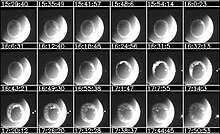33:
111:, do not inject many particles into the radiation belt, and are relatively frequent — often occurring only a few hours apart from each other. Substorms can be more intense and occur more frequently during a geomagnetic storm when one substorm may start before the previous one has completed. The source of the magnetic disturbances observed at the Earth's surface during geomagnetic storms is the
20:
36:
40:
38:
34:
39:
27:
spacecraft showing the aurora and Earth's upper atmosphere. The glowing side is the atmosphere lit up by the Sun's light energy and the oval of light is the aurora. During a substorm the auroral oval brightens in a localized area and then suddenly breaks into many different forms that expand both
37:
107:, and occur once or twice a month during the maximum of the solar cycle and a few times a year during solar minimum. Substorms, on the other hand, take place over a period of a few hours, are observable primarily at the
141:
In 2012, the THEMIS satellite mission observed the dynamics of rapidly developing substorms, confirming the existence of giant magnetic ropes and witnessed small explosions in the outskirts of Earth's magnetic field.
35:
134:
satellites have registered the magnetic field dropping to half of its normal strength during a substorm. The most visible indication of a substorm is an increase in the intensity and size of
72:" of the magnetosphere and injected into the high latitude ionosphere. Visually, a substorm is seen as a sudden brightening and increased movement of
84:
used the term substorm about 1960 which is now the standard term. The morphology of aurora during a substorm was first described by
99:
in that the latter take place over a period of several days, are observable from anywhere on Earth, inject a large number of
44:
Short video featuring commentary by David Sibeck, project scientist for the THEMIS mission, discussing a visualization of
28:
toward Earth's pole and equator. This is exactly what Shun-ichi
Akasofu (1964) drew in his auroral substorm illustration.
265:
130:, roughly 2% of the total magnetic field strength in that region. The disturbance is much greater in space, as some
115:, whereas the sources of magnetic disturbances observed on the ground during substorms are electric currents in the
89:
81:
138:. Substorms can be divided into three phases: the growth phase, the expansion phase, and the recovery phase.
330:
348:
65:
353:
45:
234:
178:
306:
230:
193:
104:
8:
160:
197:
135:
123:
77:
73:
261:
242:
96:
85:
24:
238:
201:
358:
131:
285:
206:
179:"Evolution of the dispersionless injection boundary associated with substorms"
342:
108:
127:
112:
69:
221:
Akasofu, S.-I. (April 1964). "The development of the auroral substorm".
116:
331:
http://www.nasa.gov/mission_pages/themis/auroras/northern_lights.html
19:
283:
165:. New York and Christiania (now Oslo): H. Aschehoug & Co.
284:
Stern, David P. & Peredo, Mauricio (25 November 2001).
23:
A series of images made by ultraviolet light imager on the
328:
NASA Spacecraft Make New
Discoveries About Northern Lights
100:
76:. Substorms were first described in qualitative terms by
260:. Washington, D.C.: Am. Geophysical Union. p. 488.
122:
Substorms can cause magnetic field disturbances in the
162:The Norwegian Aurora Polaris Expedition 1902-1903
340:
176:
220:
68:that causes energy to be released from the "
205:
177:Sarris, T. & Li, X. (30 March 2005).
158:
80:which he called polar elementary storms.
88:in 1964 using data collected during the
31:
18:
279:
277:
255:
341:
299:
274:
16:Short term magnetosphere disturbance
152:
13:
14:
370:
64:, is a brief disturbance in the
126:up to a magnitude of 1000
321:
309:. Southwest Research Institute
249:
214:
170:
167:out-of-print, full text online
90:International Geophysical Year
1:
159:Birkeland, Kristian (1913) .
145:
56:, sometimes referred to as a
243:10.1016/0032-0633(64)90151-5
95:Substorms are distinct from
7:
223:Planetary and Space Science
10:
375:
207:10.5194/angeo-23-877-2005
258:Magnetospheric Substorms
235:1964P&SS...12..273A
58:magnetospheric substorm
49:
29:
66:Earth's magnetosphere
43:
22:
256:Potemra, T. (1991).
105:outer radiation belt
198:2005AnGeo..23..877S
186:Annales Geophysicae
119:at high latitudes.
97:geomagnetic storms
78:Kristian Birkeland
50:
30:
349:Planetary science
86:Syun-Ichi Akasofu
41:
366:
333:
325:
319:
318:
316:
314:
303:
297:
296:
294:
292:
281:
272:
271:
253:
247:
246:
218:
212:
211:
209:
183:
174:
168:
166:
156:
62:auroral substorm
42:
374:
373:
369:
368:
367:
365:
364:
363:
339:
338:
337:
336:
326:
322:
312:
310:
305:
304:
300:
290:
288:
282:
275:
268:
254:
250:
219:
215:
181:
175:
171:
157:
153:
148:
32:
17:
12:
11:
5:
372:
362:
361:
356:
351:
335:
334:
320:
298:
273:
266:
248:
229:(4): 273–282.
213:
192:(3): 877–884.
169:
150:
149:
147:
144:
132:geosynchronous
82:Sydney Chapman
15:
9:
6:
4:
3:
2:
371:
360:
357:
355:
352:
350:
347:
346:
344:
332:
329:
324:
308:
302:
287:
280:
278:
269:
267:0-87590-030-5
263:
259:
252:
244:
240:
236:
232:
228:
224:
217:
208:
203:
199:
195:
191:
187:
180:
173:
164:
163:
155:
151:
143:
139:
137:
136:polar auroras
133:
129:
125:
124:auroral zones
120:
118:
114:
110:
109:polar regions
106:
102:
98:
93:
91:
87:
83:
79:
75:
71:
67:
63:
59:
55:
47:
26:
21:
354:Geomagnetism
327:
323:
311:. Retrieved
301:
289:. Retrieved
257:
251:
226:
222:
216:
189:
185:
172:
161:
154:
140:
121:
113:ring current
94:
74:auroral arcs
61:
57:
53:
51:
46:reconnection
286:"Substorms"
343:Categories
307:"Substorm"
146:References
117:ionosphere
103:into the
313:24 March
291:21 March
54:substorm
231:Bibcode
194:Bibcode
48:fronts.
264:
60:or an
359:Earth
182:(PDF)
25:Polar
315:2010
293:2010
262:ISBN
101:ions
70:tail
239:doi
202:doi
345::
276:^
237:.
227:12
225:.
200:.
190:23
188:.
184:.
128:nT
92:.
52:A
317:.
295:.
270:.
245:.
241::
233::
210:.
204::
196::
Text is available under the Creative Commons Attribution-ShareAlike License. Additional terms may apply.
